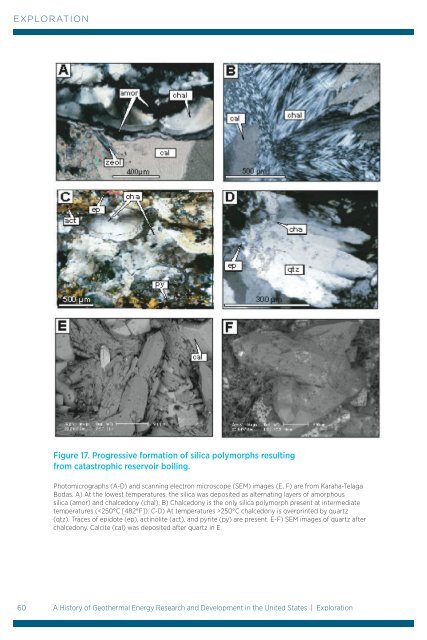A History of Geothermal Energy Research and Development in the ...
A History of Geothermal Energy Research and Development in the ...
A History of Geothermal Energy Research and Development in the ...
Create successful ePaper yourself
Turn your PDF publications into a flip-book with our unique Google optimized e-Paper software.
EXPLORATION<br />
Figure 17. Progressive formation <strong>of</strong> silica polymorphs result<strong>in</strong>g<br />
from catastrophic reservoir boil<strong>in</strong>g.<br />
Photomicrographs (A-D) <strong>and</strong> scann<strong>in</strong>g electron microscope (SEM) images (E, F) are from Karaha-Telaga<br />
Bodas. A) At <strong>the</strong> lowest temperatures, <strong>the</strong> silica was deposited as alternat<strong>in</strong>g layers <strong>of</strong> amorphous<br />
silica (amor) <strong>and</strong> chalcedony (chal). B) Chalcedony is <strong>the</strong> only silica polymorph present at <strong>in</strong>termediate<br />
temperatures (250°C chalcedony is overpr<strong>in</strong>ted by quartz<br />
(qtz). Traces <strong>of</strong> epidote (ep), act<strong>in</strong>olite (act), <strong>and</strong> pyrite (py) are present. E-F) SEM images <strong>of</strong> quartz after<br />
chalcedony. Calcite (cal) was deposited after quartz <strong>in</strong> E.<br />
60 A <strong>History</strong> <strong>of</strong> <strong>Geo<strong>the</strong>rmal</strong> <strong>Energy</strong> <strong>Research</strong> <strong>and</strong> <strong>Development</strong> <strong>in</strong> <strong>the</strong> United States | Exploration

















